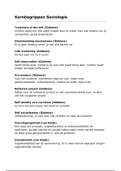ACA 122 Final Exam Study Guide 100%
Correct!!
Understand the expectations of college students and how college is different from high school. -
ANSWER-Actively prepare for class
-Participate in class
-Seek out resources when you need help
-Be responsible for your own learning
Know what information should be included on a college syllabus. - ANSWER-Instructor's contact
information (Phone, email, office location & office hours)
-Important class policies (Attendance, withdrawal, late work, grading policies)
-Outline of instruction (Schedule, test dates, assignments, & homework)
Discuss the importance of attendance in college and understand the difference between dropping a
class and withdrawing from a class. - ANSWERCourses dropped after the last day to drop for the term
and on or before the 60% date of the semester or term are considered withdrawals.
Know the difference between the grades of W and WF. - ANSWERThe grade of WP counts the same
as a grade of W in the determination of the student's GPA.
Grade of W - ANSWERStudents who withdraw or who are withdrawn for any reason, including
attendance policy violations, on or before the 60% point are assigned a grade of W.
Grade of WP - ANSWERStudents who withdraw or who are withdrawn after the 60% point with
legitimate, extenuating circumstances, will be assigned a grade of WP.
Grade of NA - ANSWERStudents who never attend and do not drop on or before the drop deadline
are assigned a grade of NA (never attended).
Grade of WF - ANSWERStudents who withdraw or who are withdrawn after the 60% point with no
legitimate, extenuating circumstances will be assigned a grade of WF. If a student stops attending
class before the last test, final project, or final exam and has violated the attendance policy, that
student will receive the grade of WF. The grade of WF counts the same as an F in the determination
of the student's GPA.
Grade of F - ANSWERA grade of F indicates that the student completed the class but earned the F
(failing) grade. If a student stops attending class before the last test, final project, or final exam but
has not violated the attendance policy, that student will receive the grade earned, including zeros for
the work missed.
Grade of I - ANSWERA grade of I (incomplete) may be given at the discretion of the instructor if the
instructor decides that the student (who has contacted the instructor to request an incomplete) has
a legitimate reason for missing the last test, final project, final exam, or other assignment.
Know how to calculate a GPA. - ANSWERTotal Grade Points/Total Credit Hours = GPA
, What is plagiarism and what are the consequences? - ANSWERTaking someones ideas without
permission or citation. Results in failing grade in assignment or course
What is financial literacy? - ANSWERThe knowledge and skill set necessary to be an informed
consumer and manage finances effectively
What is a credit score and why is it important? - ANSWERA credit score is a statistical number that
evaluates a consumer's creditworthiness and is based on credit history. Lenders use credit scores to
evaluate the probability that an individual will repay his or her debts. A person's credit score ranges
from 300 to 850, and the higher the score, the more financially trustworthy a person is considered to
be.
What financial aid options are available to students? - ANSWERGrants, work-study programs, and
loans
Grants - ANSWERMonies that do NOT have to be paid back
Work-study programs - ANSWERRequire employment in order to be paid
Loans - ANSWERMonies that will have to be repaid; repayment begins 6 months after graduation
from a program or if a student drops below 6 credit hours
What is Satisfactory Academic Progress and how is it measured? - ANSWERTo maintain financial aid
eligibility, students must meet SAP criteria:
-Cumulative GPA of 2.0
-Cumulative credit hour completion rate of 67%
-Attempt no more than 150% of credit hours required for graduation
What is goal discernment and what are the stages? - ANSWERSelf-Assessment, Goal Exploration,
Goal Setting
What is a Holland Code and what are the 6 personality types it identifies? - ANSWERProposes six
personality types matched with six work environments: Realistic, Investigative, Artistic, Social,
Enterprising, and Conventional (summarized as RIASEC)
Why would you need to know your Holland Code? - ANSWERPersonalities and characteristics for
college majors, hobbies, abilities, and related careers
Explain the differences between visual, auditory and kinesthetic learners. - ANSWER-Auditory
learners do best with information that they can hear.
-Visual learners like to have something they can see.
-Kinesthetic learners are those who enjoy some hands-on experimentation or lab work to help them
fully comprehend the information in front of them.
What does the term "multi-modal learner" mean? - ANSWERFlexible about how you give and receive
information, which can make it easier for you to adapt to the mode of information you are presented
with.
What are the three phases of metacognition? - ANSWERPlanning, Monitoring, Evaluating





